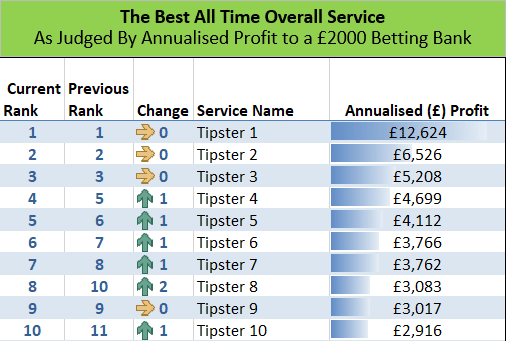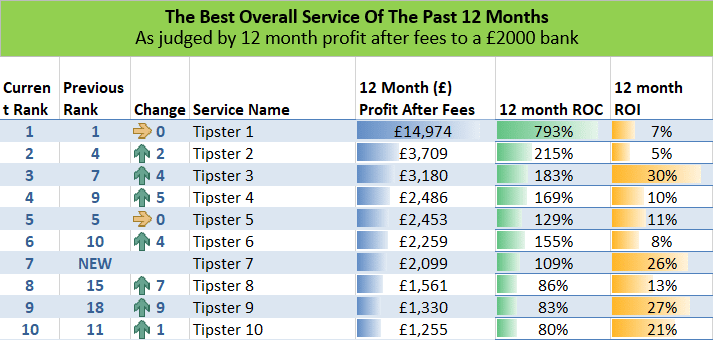Last week saw the release of the latest SBC Tipster Profit Report – your ticket to finding out just who the best-rated tipster services actually are and those experts with a proven track record of success.
This Tipster Profit Report contains the exact profit and loss details of more than 56 different short-listed tipsters, so you can see how they their tipping performance stacks up and who you should follow with your money.
It’s not just tipster results that we evaluate either, but everything from odds availability, customer service, practicality, cost and betting bank growth. All with the central aim of informing you as to who the best tipsters actually are.
And so to showcase the power of this report, I wanted to share with you extracts from it, including 3 different tipster tables starting with those under £30 a month…
The Top 10 Low Cost Racing Tipster Services
To first showcase how this Tipster Profit Report can help you, check out the extract taken from the Low Cost Racing Tipster Table found within it below.
Although the names of each tipster are hidden (this is available to Smart Betting Club members only), you can see how much profit is being made for very little outlay each month.
As the information above is protected for full SBC members only, I have removed the tipsters named and identified them as 1 through 10 for the purposes of this email. Full disclosure on each service can be found in the Tipster Profit Report itself
The top low cost tipster has made an annualised profit figure of £3.083 for just a £10.40 monthly fee. In fact, each of the top 10 low cost racing tipsters are making in excess of £1,000 annualised profit figures for less than a £30 outlay per month.
What is Annualised Profit and how do we generate the figures in the table above?
The Annualised Profit figure helps to put a tipsters results into context as it takes several performance figures together, including betting bank growth to provide an estimated yearly average profit figure.
This is judged if operating to a £2000 betting bank for each tipster to provide a standard comparison tool, although it’s important to make clear you don’t need as much as £2000 to get started – it is just a sum for easy comparison.
The Top 10 Performing All-Time Tipster Services
Next, let me show you an example of our ‘Best All Time Overall Service’ table.
We judge each tipster based on the annualised profit they have made if working to a £2000 betting bank. As you can see, to these standardised Annualised Profit figures, the returns stated by the top 10 are quite exceptional…
To explain how the table works, if you had started following Tipster 1 with a £2000 betting bank, in an average year you would expect to make a profit of £12,624
Even Service 10, would have more than doubled your starting bank in an average year with a profit of £2,916.
The Top Ten Tipsters From The Past 12 Months
In each Tipster Profit Report, we also produce several other ‘tipster tables’ so you can quickly and easily find the best, in-form services.
These tipster tables are also designed to be completely realistic, so you can find out the total profits after all costs have been deducted, such as tipster subscription fees.
For example, check out the top tipsters from our Best Overall Service Of The Past 12 Months table below (again from this latest report), which lists the top performing tipsters from the last 12 months if working to a £2000 betting bank.
Once again, we have blanked out the names as this is for full members only, but as you can see, the top tipsters are making an excellent profit. This table also includes other key figures such as Return on Capital (12 month ROC) and Return on Investment (12 month ROI).
The highlight of this table is clearly Tipster 1 who made a £14,974.00 profit AFTER FEES in the past 12 months and all from just the £2,000 starting point.
Next up is Tipster 2 with a £3,709 profit and even Tipster 10 has made a £1,255 profit from a £2000 starting point after fees over the past 12 months.
Track The Best Tipsters In Each Profit Report
The Tipster Profit Report is incredibly unique as its the only place you can read about the best betting tipsters and just how they continually perform.
Reviewing tipsters is one thing, but understanding how and if they are able to maintain a profitable record, plus how they compare to other tipsters is absolutely vital.
All of which is why my crack team of SBC analysts verify and ‘proof’ hundreds of different tipsters every month and keep detailed records of their results to help compile each Tipster Profit Report.
After all, any tipster can pick a few winners by luck, but those tipsters that make profits year-in, year-out are the ones to follow and can be found in our Tipster Profit Report.
The goal as ever is to help you with your betting, whether joining as a total newcomer or experienced punter.
You can pick up a copy of the Tipster Profit Report the instant you join the Smart Betting Club.
Best of all, you can currently join and take advantage of our lowest ever membership prices.
Subscribe NOW to the Smart Betting Club
Best Regards,
Peter Ling
Smart Betting Club Editor






